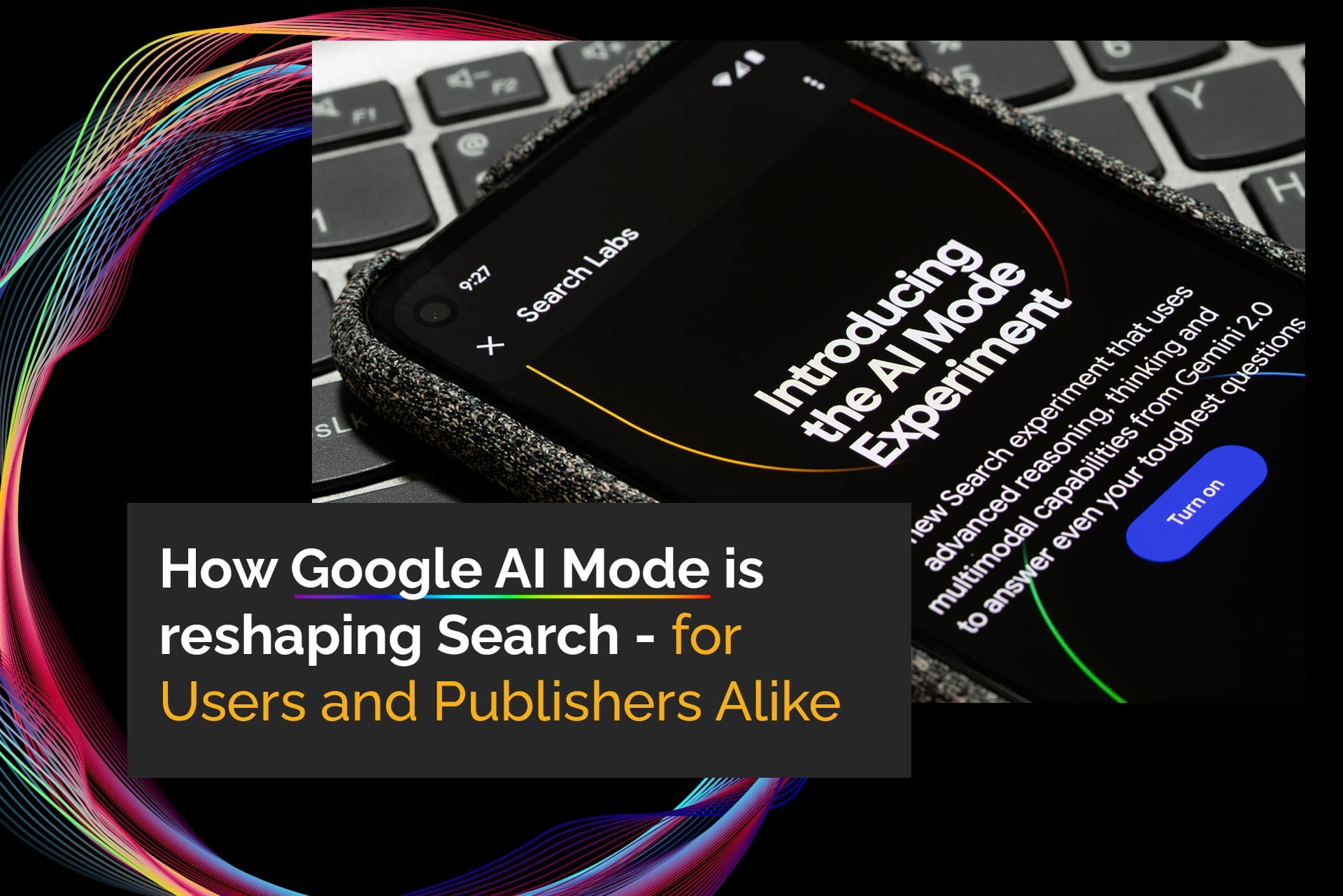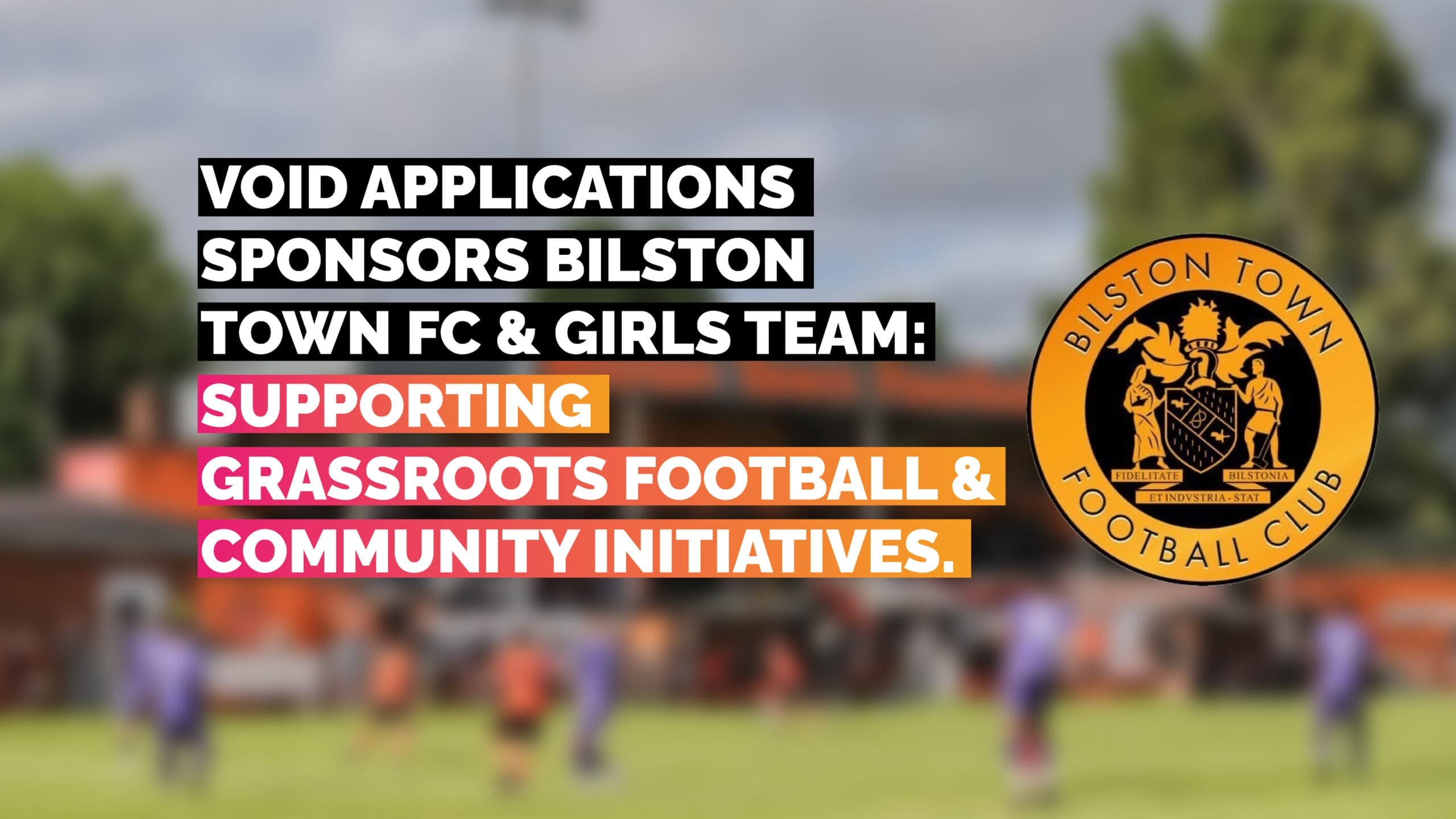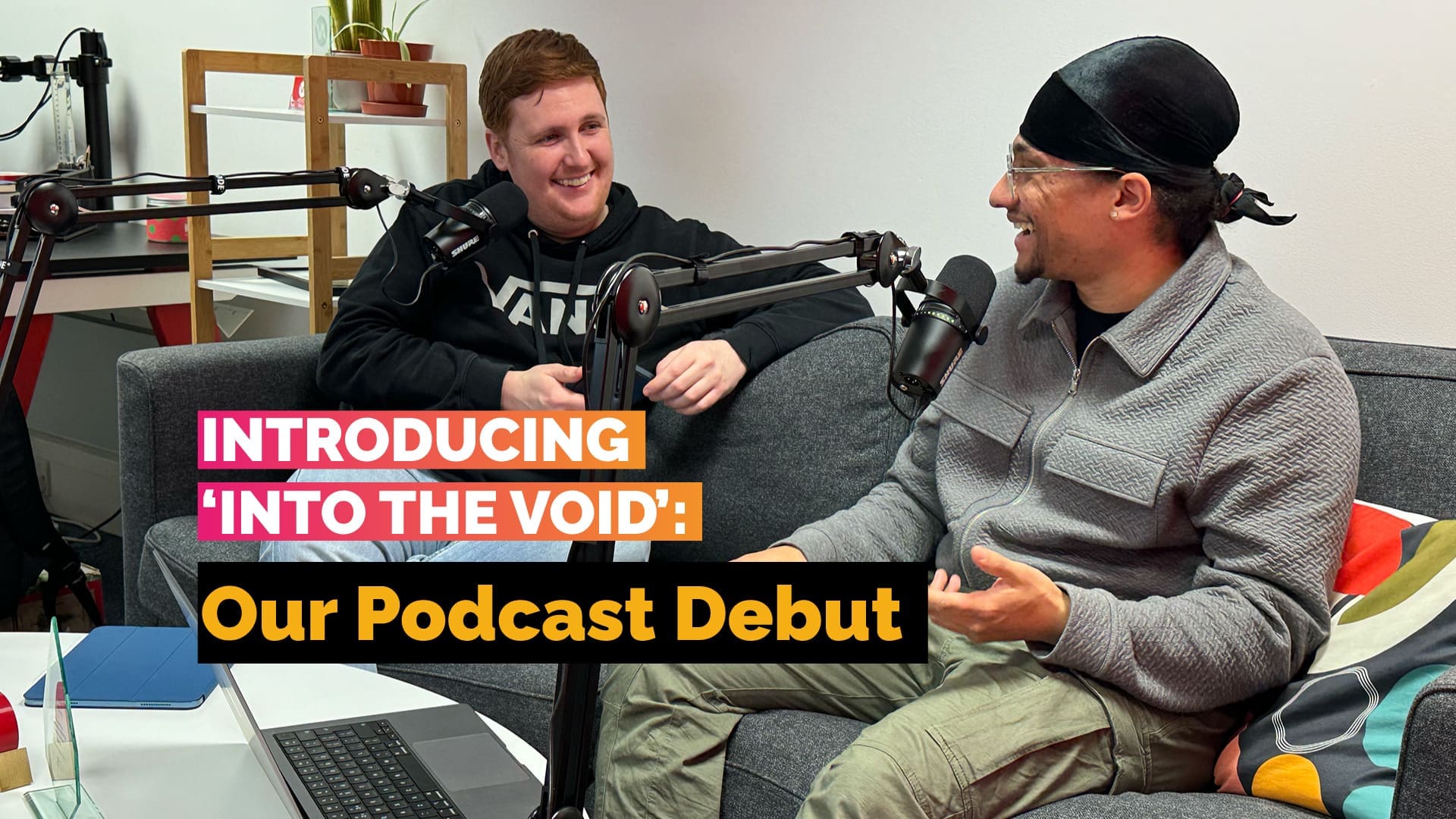Table of Contents
What is Google AI Mode?
AI Mode uses Google’s Gemini AI right inside the search page. Instead of offering a list of links, the search results will now take on a chatbot-style format where users can ask questions, reminiscent of long-tail keyword searches1. This includes the ability of asking multi-layered queries and receiving direct answers back, along with curated links for further exploration or research. The hot debate right now is, whether or not the curated links that are given will be allowed to shine, or will they be completely ignored? As the AI Mode answers the query directly within the search, and current findings are showing that user behaviours aren’t necessarily clicking through and are finding what they need from the AI generated response.
In addition to these new capabilities, Google is still going to offer the option to view traditional search results, so users can choose to interact with the AI or continue to find links in what’s now considered the ‘old-fashioned way’, but it’s a likely guarantee that AI Mode Search will be at the forefront of the Google experience. Google’s move to AI-powered search comes as a response to competition from other AI-powered search tools, like OpenAI’s ChatGPT, which have been gaining traction amongst avid search users.
Google’s Response to Competition from AI-Powered Search Tools
The swift rise of AI-powered search tools has prompted Google to accelerate its own AI integration, aiming to maintain its leadership in the search landscape. While platforms like OpenAI’s ChatGPT, Perplexity AI, and others have introduced more conversational and context-aware search experiences, the overall impact on Google’s dominance remains limited in terms of market share (Google still handles the vast majority of searches – approximately over 93% of the global search market). So why with such vigour and haste has Google set out to achieve such a complex AI driven, return of search?
The Emergence of AI Search Tools
AI models such as ChatGPT have gained significant user attention since their launch, offering interactive, conversational answers that appeal to users seeking direct, nuanced responses. Other platforms like Perplexity AI and Microsoft Bing AI have also embraced advanced AI models, providing real-time, citation-backed answers and more personalised search experiences2. These tools are particularly valued for their ability to handle complex queries and collate information from multiple sources, reducing the need for users to sift through traditional search results.
Due to this, there’s been a noticeable shift in user preference towards faster, more precise answers delivered through natural language interfaces. According to a survey carried out by Gartner in 2023, as many as 79% of consumers expected to use AI-enhanced search within the next year (2024), reflecting a growing demand for efficient, conversational search experiences3. This trend has continued to pressure traditional search engines like Google to evolve and innovate, which brings us to the implementation of Google AI Mode now.
A Statistical Perspective: Google vs. AI Search Tools
Despite the buzz around AI chatbots, Google remains overwhelmingly dominant in the search market. In 2024, Google handled more than 5 trillion searches, that’s approximately 14 billion per day, meaning Google maintained a 93.57% market share (so they didn’t too bad eh). By comparison, ChatGPT saw an estimated 37.5 million search-like prompts per day, accounting for just 0.25% of the search market – which is also less than Microsoft Bing (4.10%), Yahoo (1.35%), and DuckDuckGo (0.73%)4&5.
Even if all of ChatGPT’s 1 billion daily messages were search-related, its share would still be less than 1%4&5.
Within the AI search sector specifically, ChatGPT holds a substantial 80.1% share, while Google’s AI offerings account for 5.6%, and newer entrants like Perplexity command 1.5%6.
Google’s AI Integration and Market Response
Google’s introduction of features like AI Overviews and the integration of its Gemini AI model into search are strategic moves to offer a more conversational, AI-enhanced experience. These features aim to match or exceed the capabilities of newer AI-driven platforms, providing users with direct answers and greater personalisation. Google’s AI Overviews, for instance, now appear in a growing number of search results, and support multiple languages.
While Google’s move to AI-powered search reflects the increasing competitiveness of the market, the company still faces challenges from both established and emerging AI platforms. The future of search is likely to be shaped by further advancements in AI, with a focus on interactive experiences that cater to the evolving user expectations6.
The Pros of Google AI Mode
- 1. Improved User Experience
For end users, Google’s AI Mode offers a more dynamic and intuitive way to search. By answering complex questions in a conversational manner, the AI provides, what it thinks, is a richer experience that allows users to get answers quickly and efficiently without having to go through or open multiple links. Whether you’re booking a reservation or comparing product features, AI Mode promises to streamline tasks and save time. - 2. Enhanced Task Automation
Beyond simply answering questions, AI Mode can help users complete tasks directly through the interface. For example, it could assist in booking appointments, ordering products, or comparing prices. This feature could be particularly valuable for users who prefer a more interactive, efficient search experience. - 3. Conversational, Multi-Layered Queries
One of the most significant advancements is the ability to ask multi-layered questions. This makes it easier to get tailored answers, similar to how a conversation would unfold with a human. This could lead to faster, more accurate responses, reducing the need for multiple searches.
The Cons of Google AI Mode
- 1. Impact on Publishers and Content Creators
For publishers and businesses, the shift to AI Mode presents a significant challenge. Historically, Google sent a considerable amount of traffic to content creators’ websites in return for indexing their content. However, as AI Mode keeps users within Google’s ecosystem (walled garden effect), queries could be answered and even tasks completed without clicking through to external sites (zero-click search), which means publishers may see a sharp decline in organic traffic. Which also begs the question as to what will happen with Google Adverts? Recent studies show that nearly 60% of Google searches now end without a click to an external site, and this number continues to rise as AI Overviews and Google’s AI Mode become more common.
Another study found that AI-powered Overviews (these are snippets of AI-generated content that appear at the top of search results) often redirect users back to Google’s own results, meaning fewer clicks to external sources. This change could especially impact content-heavy websites, news outlets, bloggers; anywhere where traffic from search engines plays a critical role in their business model.
The relationship between Google and content creators has fundamentally shifted as we know it. Whereas Google once sent significant referral traffic to external websites in exchange for indexing their content, the rise of zero-click searches and AI-powered features has changed this dynamic which means Google will have to start to think about how they incentivise publishers and content creators or potentially lose out on up to date and fresh information, concepts and discussions to be used in their search results. - 2. Decreased Organic Click-Through Rates (CTR)
One major concern for content creators is the potential decrease in click-through rates (CTR). For top-ranking sites like Mail Online, the introduction of AI-powered summaries led to a dramatic drop in CTR, with desktop clicks falling from 13% to below 5%. This reduction in engagement is likely to impact websites that rely on search traffic for conversions. - 3. Content Creation Incentives Are at Risk
As AI answers become more prevalent and direct, the incentive for content creators to produce original material may diminish. Content creators and businesses that previously relied on Google’s organic traffic for visibility might find it harder to justify the cost and effort of content creation when much of it could be summarised or replicated by AI. This threatens the sustainability of the web’s content ecosystem.
Is this the End of Content? What Can I Do About my Website?
To the first part of the question, no. To the second, remain resilient. We saw the initial impact of AI content throw a spanner in the works with regards to SERP (Search Engine Results Pages) when Google was trying to combat the influx of data with updates to its algorithms from 2023 up until as recently as this year. These updates were made to ensure that truly useful content was shown and websites weren’t abusing AI-generated content in order to pack out their websites and forcefully hit the criteria for SEO. This came in the form of Core and Site Reputation updates, with some sites still recovering even now and taking their rightful place in top positions after being forcefully tanked by Google, working through growing pains and understanding what organic content looks like next to AI-generated prompts.
Regardless of the type of optimisation methods that will now be a hot-topic for Search Agencies to bring up as the next best thing, time and time again, a basic, fundamental on-topic content strategy will always put your site in the best light possible.
The introduction of AI Mode into Google Search isn’t the end for content creation—it’s another evolution in the way we engage with search engines. Just as previous updates like Panda and Penguin altered SEO strategies to favour high-quality content, AI Mode is simply the next step in refining how search engines potentially deliver the most relevant information to users.
While AI may drive changes in how results are presented, Google will still want to reward genuinely useful, well-researched original content; otherwise, they run the risk of turning away users. Think of AI Mode as an additional layer in the content strategy puzzle, not a replacement. It opens up new opportunities to optimise for conversational queries and long-tail search phrases that AI models are particularly good at processing.
How they decide to present the user with relevant search links and ensure the end creator is rewarded more prominently than what has been initially recorded, only time can tell, but they cannot afford to halt this traditional wheel of motion for strictly Google AI-powered results, because the well will eventually dry up.
What Does This Mean for Publishers Going Forward?
As detailed, the rise of AI Mode presents several challenges to traditional publishers, especially those who have built their business models around organic search traffic. As we shift toward a more AI-driven search experience, it’s crucial for content creators to adapt and rethink their strategies for visibility, engagement, and ultimately, conversions.
Here are some recommended actions:
- 1. Focus on SEO and Organic Traffic Optimisation
While AI-driven traffic is on the rise, traditional SEO remains a cornerstone of a successful digital strategy. Investing in traditional SEO practices remains important, as organic search traffic still delivers higher engagement and conversions compared to AI-generated referrals. To gauge the impact of your efforts and fine-tune your approach, tracking your Key Event Conversion Rate (KECVR) is a must and will be vital to assess the effectiveness of your traffic sources and ensure that your SEO strategy remains robust. - 2. Adapt Your Content Strategy
With Google’s AI Overviews reportedly reducing CTR, content creators should focus on (if not already 🙄) producing in-depth, hard-to-replicate content. By focusing on exclusive insights, expert commentary, and multimedia-driven articles, creators can offer value that goes beyond what AI-generated summaries can capture, which actually gives content creators a competitive edge right now. - 3. Build a Strong, Recognisable Brand
Now more than ever, it’s essential to create a distinctive brand identity that resonates with your audience. Focus on content that reflects your brand’s unique voice, such as think pieces, exclusive insights into your sector, or community-driven initiatives that show your values and ethos. Content that showcases your brand’s values and expertise will help differentiate you from competitors, which means you should be aiming to do this anyway. Additionally, strengthening your direct engagement with your audience through newsletters, social media, and other channels can reduce your reliance on search engines for traffic, create organic touchpoints and help to build lasting, direct connections with your followers.
Conclusion
In some respects, we’ve been here before, and we’ll be here again. There’s not a day on the internet where there isn’t change for the better or worse, but you can rest assured that if you are actively taking steps to improve your web presence regardless of the trend, it will pay off in the long run.
Google AI Mode does represent a transformative shift in how we will search and interact with the web. While the integration of AI offers a more intuitive and time-saving experience for users, it poses significant challenges for content creators and businesses that rely on traditional search engine traffic. But like most challenges, understanding the nature of it, learning what can be done, implemented and improved upon is what makes the process rewarding, stabilises your website’s performance, and in turn creates gains.
As we move into this new era of AI-driven search, adapting to these changes and diversifying traffic sources will be key to maintaining visibility and engagement. The future of search may look different, but with the right strategies in place, publishers can and will continue to thrive.
Sources
1. Semrush – Long-Tail Keywords: What They Are & How to Use Them in 2025
2. LinkedIn – Best AI Search Engines in 2025 by Analytics Insight
3. Gartner – Gartner Predicts 50% of Consumers Will Significantly Limit Their Interactions with Social Media by 2025
4. Search Engine Land – Google Search is 373x bigger than ChatGPT Search
5. Digital Information World – ChatGPT Can’t Keep Up: Google Handles 373x More Traffic and Keeps Growing
6. Business Tech Weekly – ChatGPT’s Market Share: Transforming AI Search While Traditional Engines Decline




















